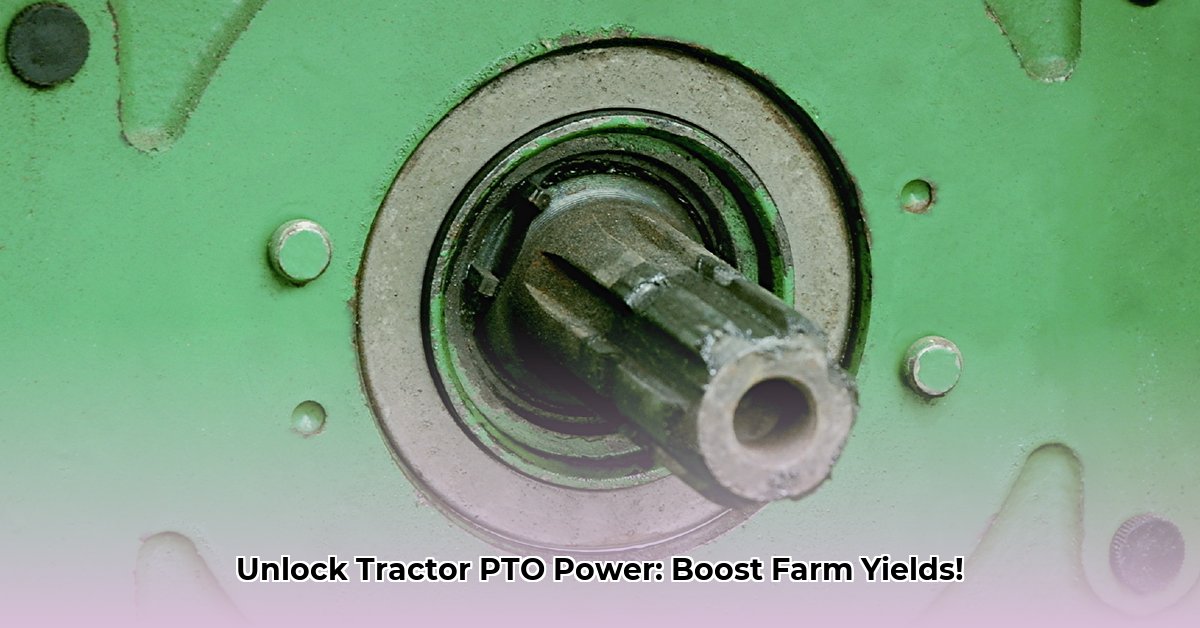
Understanding Your Tractor's Power Take-Off (PTO)
Your tractor's Power Take-Off (PTO) is the unsung hero of farm efficiency. It's the crucial link between your tractor's engine and the implements that perform the actual fieldwork – from mowing and baling to tilling and harvesting. This guide will dissect how it works, offering actionable advice to optimize your farm’s productivity and fuel efficiency. Did you know that choosing the right PTO can significantly impact your bottom line? Let's explore how. For more in-depth information on PTO types, check out this helpful resource: PTO types explained.
How Does Tractor PTO Work? A Step-by-Step Guide
The PTO's function is simple yet powerful: it transfers engine power to external implements. Let’s break down the six key steps:
Engine Power Generation: The tractor's engine generates mechanical power. This is the fundamental energy source driving everything.
Transmission Power Transfer: The engine's power is channeled through the tractor's transmission. This system controls power output and speed.
PTO Engagement: The operator engages the PTO, activating the connection to the implement. This usually involves a lever or switch.
Shaft Rotation: The PTO shaft starts spinning at the pre-selected speed (typically 540 RPM or 1000 RPM). This speed determines the implement's operating speed.
Implement Connection: The spinning shaft connects mechanically to the implement, providing the power needed to function.
Power Transfer and Implement Operation: Power flows from the tractor to the implement, enabling its operation.
Decoding PTO Types: Finding the Right Fit for Your Needs
Several PTO types cater to various operational needs. Selecting the right one hinges on your typical tasks and equipment.
Live PTO: Remains engaged even when the tractor's clutch is disengaged. Continuous operation is efficient, but demands more operator awareness for safety.
Independent PTO: Can operate independently of the tractor's transmission. This means the implement operates at the required speed without relying on the tractor's movement. Highly versatile and preferred by many farmers.
Transmission PTO: Directly linked to the tractor's transmission; simpler and often less expensive. However, implement speed is tied to tractor speed, limiting adaptability.
Ground Speed PTO: Automatically adjusts PTO speed based on the tractor's ground speed. Ideal for tasks requiring a constant relationship between the tractor's movement and implement's operation. This provides improved precision and efficiency.
Connecting the Dots: PTO Shafts Explained
The PTO shaft forms the physical link between the tractor and the implement. Two main types exist:
Spline Shaft: A robust, interlocking design capable of handling higher power loads and offering increased durability.
Square Shaft: A simpler, less powerful type frequently found in older equipment. Carefully ensure compatibility with your implements to prevent damage.
RPM: Speed Matters for Efficiency and Equipment Longevity
PTO speed is measured in revolutions per minute (RPM). Understanding this is critical for optimal performance and equipment protection:
540 RPM: The standard speed for many implements; a balance between power and speed for common farming tasks.
1000 RPM: Generally used for high-power applications. However, using the wrong RPM stresses equipment and can cause damage. Always confirm compatibility with your implement’s specifications.
"Choosing the correct RPM is essential, as it directly impacts both fuel efficiency and the lifespan of your equipment," advises Dr. Emily Carter, Agricultural Engineering Professor at Purdue University.
How to Choose the Most Fuel-Efficient Tractor PTO System
Fuel efficiency is a major concern for farmers. This section delves into choosing the most effective approach.
Assess Implement Needs: Determine which implements you'll use most frequently and their speed requirements.
Check Tractor Specifications: Identify your tractor's available PTO speeds (540 RPM, 1000 RPM, or both).
Match PTO to Implement: Select the appropriate PTO speed matching the implement's specifications.
Evaluate Hydraulic Systems: For hydraulic implements, ensure the pump is adequately sized and speed-matched to the PTO.
Consider Engine Size and Horsepower: Efficiently match your engine’s power capabilities to the task requirements.
Regular Maintenance: Keep your tractor and PTO system well-maintained for peak performance and fuel economy.
Efficient Operating Practices: Smooth operation, avoiding unnecessary idling, and proper implement adjustment reduce fuel consumption.
Troubleshooting and Maintenance for Optimal PTO Performance
Regular maintenance safeguards PTO reliability and longevity. Consider these key steps:
Lubrication: Regular lubrication of the PTO shaft and components reduces wear and ensures smooth operation.
Inspection: Regularly check the PTO for any signs of damage, wear, or loose components.
Replacement: Promptly replace worn parts to avert more extensive and costly repairs down the line.
Common issues include clutch problems, damaged PTO shafts, and incorrect engagement. Always consult your owner's manual for specific troubleshooting procedures.
Key Takeaways: Maximizing Your Tractor PTO's Potential
Match PTO speed precisely to implement needs: This is paramount for both fuel efficiency and equipment's longevity.
Consider your tractor's specifications: Pay attention to the engine’s RPM range and hydraulic specifications (if relevant).
Regular maintenance is paramount: It minimizes wear and tear, maximizing your equipment’s lifespan and fuel efficiency.
Understanding and selecting the correct PTO type is critical: Consider the nature of your tasks to choose a setup maximizing efficiency.
By implementing these guidelines, farmers can significantly improve their operations, increase efficiency, and reduce costs. Remember, a well-maintained and appropriately used PTO is a cornerstone of a productive and profitable farm.